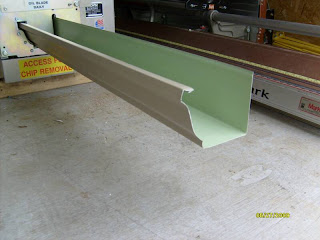
Seamless rain gutters have been around for over 40 years. By feeding a coil of pre-finished material into a forming machine, we are able fabricate the desired shape and length of gutter required. Each section is seamless, and has the obvious advantage of being virtually leak proof and extremely sturdy. Installed with inside hidden hangers and stainless steel screws, there are no unsightly nails to diminish the beauty of your home, and more importantly, screws will not pull loose like the nails used years ago.
Aluminium is the most frequently used metal for seamless gutters, is available in a wide range of colors, and considered to be the best value for your dollar. Typical K style gutters are most frequently used because of its ability to hold and flow a large amount of water to the downspouts. Seamless aluminium gutters are pre-finished with baked on enamel that provides superior protection from the elements. And aluminium will not degraded or deteriorate for many hundreds of years, so a lifetime material warranty is provided when new aluminium gutters are installed on your home. Other materials are occasionally used, such as copper or galvanized steel, but aluminium is by far the most common, and is used by home builders to meet local standards.
A commonly asked question regarding gutters concerns their size. In most areas of the country 5 inch gutters are the norm. So the question is would 6 inch gutters be better? And the answer is no. Just think about adding another inch of gutter coming off the roof. Very simply it would just provide more area for rain to fall into the gutter. If it seems as if the water is filling up the gutter, the most likely culprit would be the downspout. After making sure that the downspout isn’t clogged up, you might consider using a bigger one. After all that is where the water must eventually discharged. A gutter professional can easily assess your needs in this regard. We at Alexandra Enterprises “Everything Gutter” are committed to solving your gutter issues in the most practical and expeditious manner. We assess your needs and have your best interest in mind. Contact us for a free estimate and visit the website at www.everythinggutter.com.



